Project Management: Risk Management Project at Wilson & Jones
VerifiedAdded on 2022/01/05
|54
|5049
|20
Project
AI Summary
This project management assignment explores various facets of risk management within an organizational context, focusing on the case of Wilson & Jones. The assignment begins with an introduction to the complexities of organizational management and the importance of forecasting. It then addresses multiple assessment questions related to risk objectives, stakeholder involvement, risk classification, and the risk analysis process. Detailed answers cover risk context, identification methods, and the significance of the project client. The assignment further delves into the components of a risk register, steps to identify and control risks, and different risk treatment responses. It also examines risk context, methodology, roles and responsibilities, and reporting. The review of risk, changes in the risk environment, and the effectiveness of risk management processes are discussed. The document also touches on the importance of internal control systems, risk response strategies, and the evaluation of project outcomes. It identifies the strengths and weaknesses of a risk management plan, organizational standards, and the qualitative and quantitative characteristics of a risk management strategy. Finally, the assignment presents risk objectives, standards, and a risk context template for Wilson & Jones, along with a table detailing potential project risks, their likelihood, consequences, and proposed mitigation strategies. The assignment provides a comprehensive overview of risk management principles and their practical application.
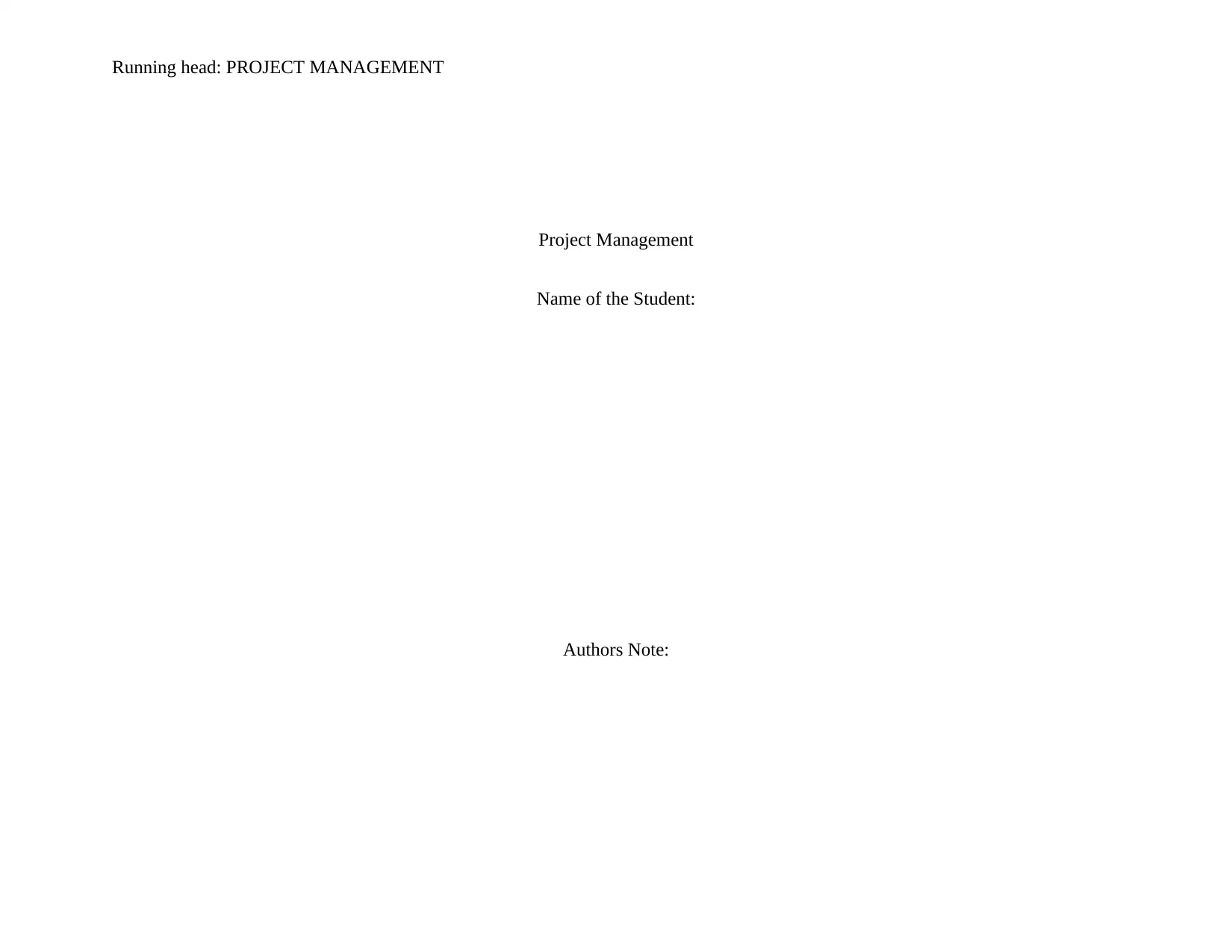
Running head: PROJECT MANAGEMENT
Project Management
Name of the Student:
Authors Note:
Project Management
Name of the Student:
Authors Note:
Paraphrase This Document
Need a fresh take? Get an instant paraphrase of this document with our AI Paraphraser
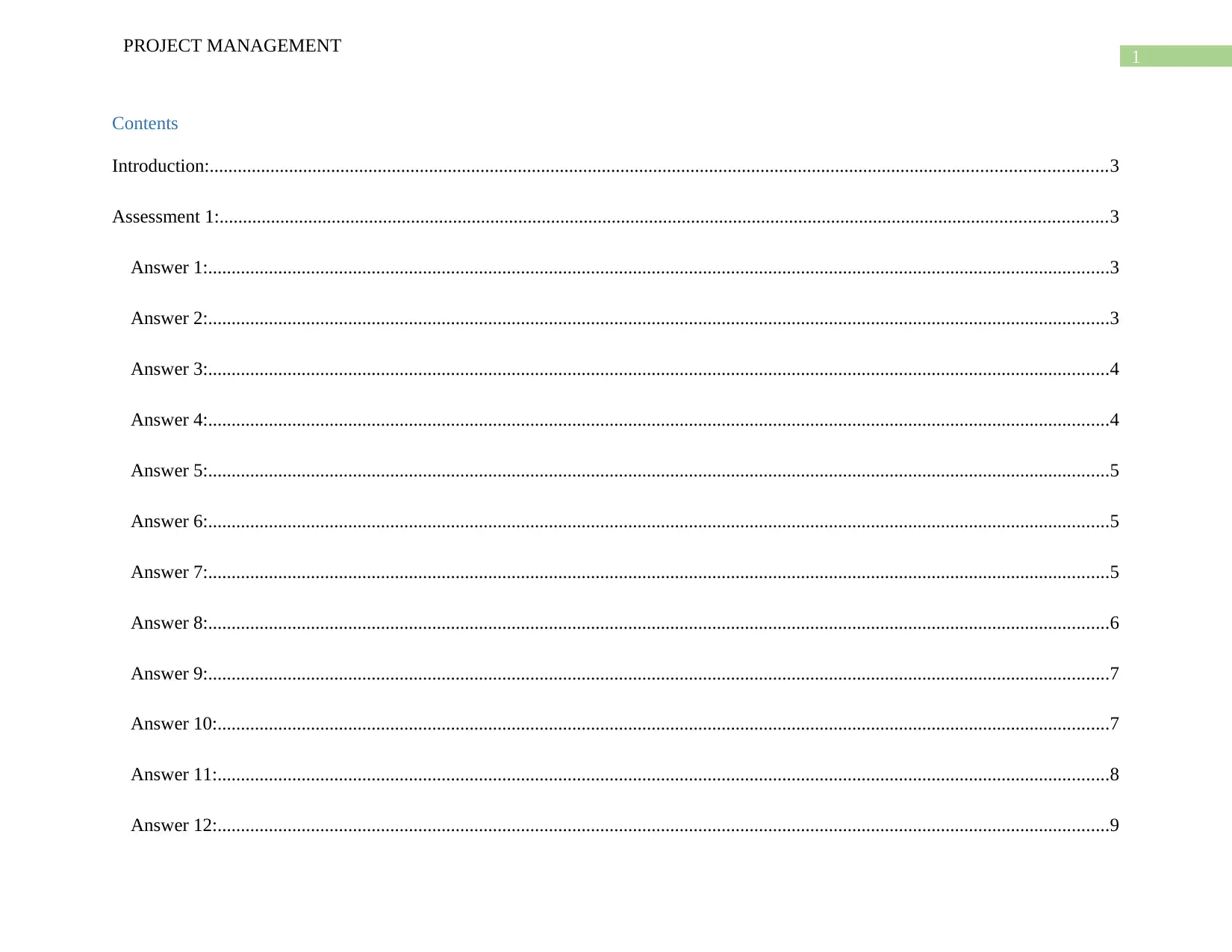
1
PROJECT MANAGEMENT
Contents
Introduction:................................................................................................................................................................................................3
Assessment 1:..............................................................................................................................................................................................3
Answer 1:.................................................................................................................................................................................................3
Answer 2:.................................................................................................................................................................................................3
Answer 3:.................................................................................................................................................................................................4
Answer 4:.................................................................................................................................................................................................4
Answer 5:.................................................................................................................................................................................................5
Answer 6:.................................................................................................................................................................................................5
Answer 7:.................................................................................................................................................................................................5
Answer 8:.................................................................................................................................................................................................6
Answer 9:.................................................................................................................................................................................................7
Answer 10:...............................................................................................................................................................................................7
Answer 11:...............................................................................................................................................................................................8
Answer 12:...............................................................................................................................................................................................9
PROJECT MANAGEMENT
Contents
Introduction:................................................................................................................................................................................................3
Assessment 1:..............................................................................................................................................................................................3
Answer 1:.................................................................................................................................................................................................3
Answer 2:.................................................................................................................................................................................................3
Answer 3:.................................................................................................................................................................................................4
Answer 4:.................................................................................................................................................................................................4
Answer 5:.................................................................................................................................................................................................5
Answer 6:.................................................................................................................................................................................................5
Answer 7:.................................................................................................................................................................................................5
Answer 8:.................................................................................................................................................................................................6
Answer 9:.................................................................................................................................................................................................7
Answer 10:...............................................................................................................................................................................................7
Answer 11:...............................................................................................................................................................................................8
Answer 12:...............................................................................................................................................................................................9
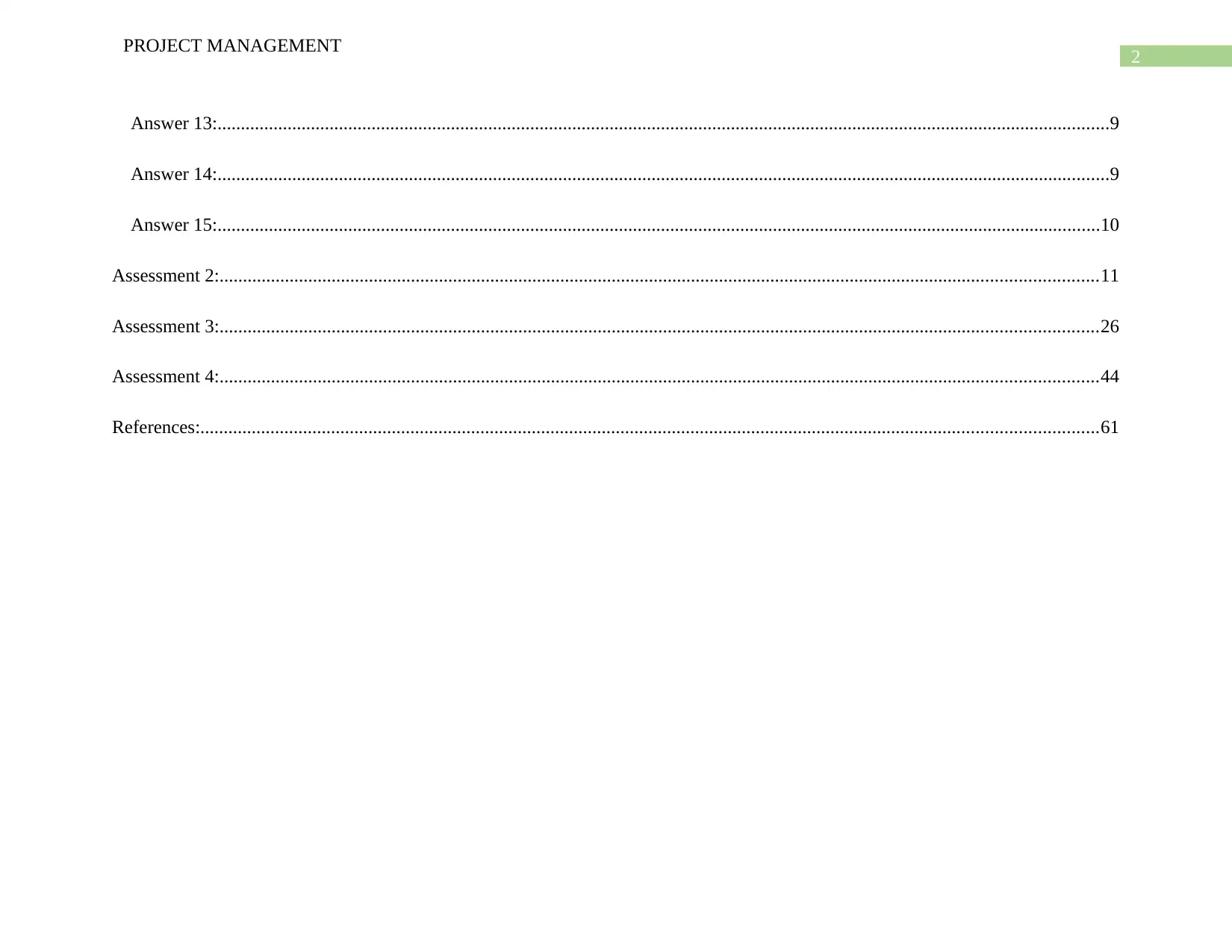
2
PROJECT MANAGEMENT
Answer 13:...............................................................................................................................................................................................9
Answer 14:...............................................................................................................................................................................................9
Answer 15:.............................................................................................................................................................................................10
Assessment 2:............................................................................................................................................................................................11
Assessment 3:............................................................................................................................................................................................26
Assessment 4:............................................................................................................................................................................................44
References:................................................................................................................................................................................................61
PROJECT MANAGEMENT
Answer 13:...............................................................................................................................................................................................9
Answer 14:...............................................................................................................................................................................................9
Answer 15:.............................................................................................................................................................................................10
Assessment 2:............................................................................................................................................................................................11
Assessment 3:............................................................................................................................................................................................26
Assessment 4:............................................................................................................................................................................................44
References:................................................................................................................................................................................................61
⊘ This is a preview!⊘
Do you want full access?
Subscribe today to unlock all pages.

Trusted by 1+ million students worldwide
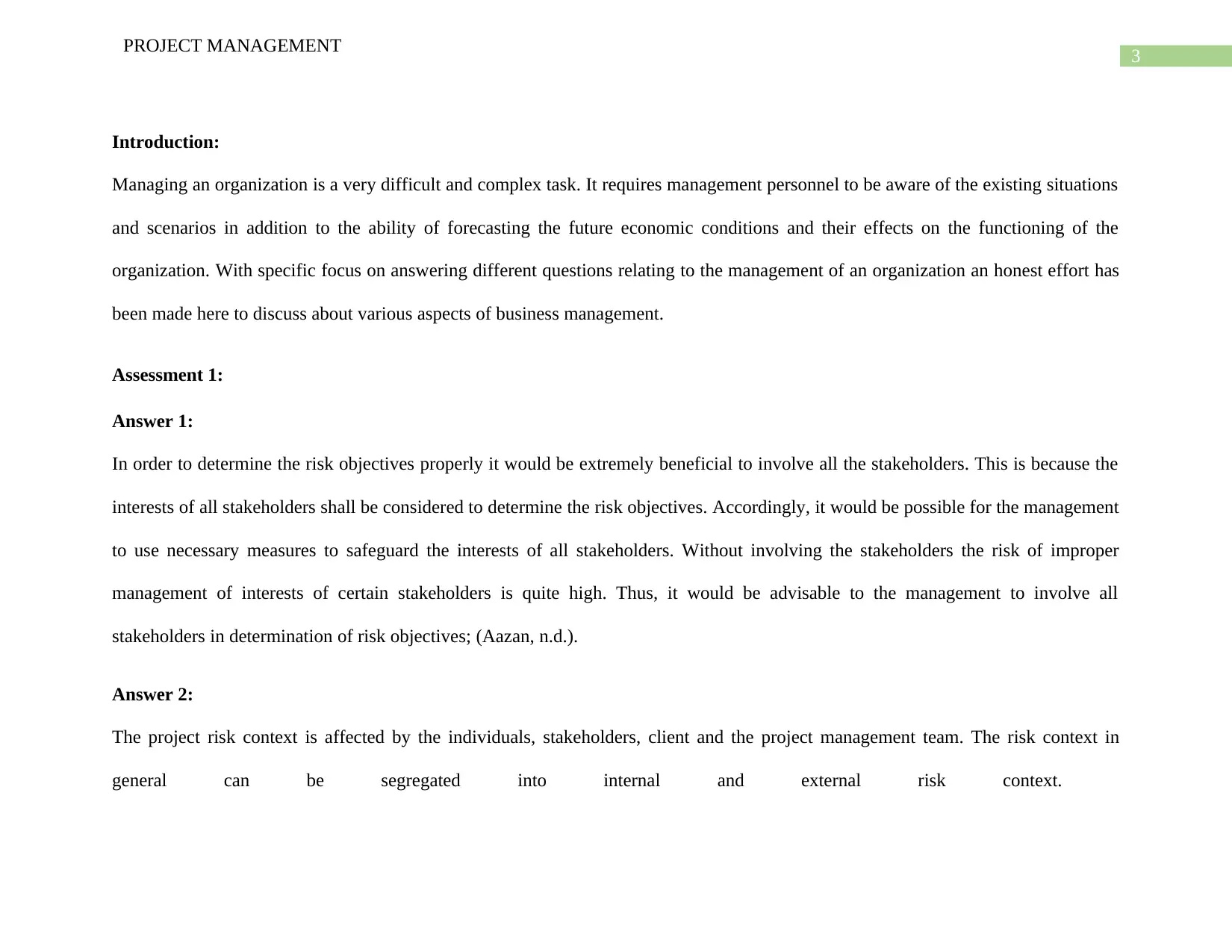
3
PROJECT MANAGEMENT
Introduction:
Managing an organization is a very difficult and complex task. It requires management personnel to be aware of the existing situations
and scenarios in addition to the ability of forecasting the future economic conditions and their effects on the functioning of the
organization. With specific focus on answering different questions relating to the management of an organization an honest effort has
been made here to discuss about various aspects of business management.
Assessment 1:
Answer 1:
In order to determine the risk objectives properly it would be extremely beneficial to involve all the stakeholders. This is because the
interests of all stakeholders shall be considered to determine the risk objectives. Accordingly, it would be possible for the management
to use necessary measures to safeguard the interests of all stakeholders. Without involving the stakeholders the risk of improper
management of interests of certain stakeholders is quite high. Thus, it would be advisable to the management to involve all
stakeholders in determination of risk objectives; (Aazan, n.d.).
Answer 2:
The project risk context is affected by the individuals, stakeholders, client and the project management team. The risk context in
general can be segregated into internal and external risk context.
PROJECT MANAGEMENT
Introduction:
Managing an organization is a very difficult and complex task. It requires management personnel to be aware of the existing situations
and scenarios in addition to the ability of forecasting the future economic conditions and their effects on the functioning of the
organization. With specific focus on answering different questions relating to the management of an organization an honest effort has
been made here to discuss about various aspects of business management.
Assessment 1:
Answer 1:
In order to determine the risk objectives properly it would be extremely beneficial to involve all the stakeholders. This is because the
interests of all stakeholders shall be considered to determine the risk objectives. Accordingly, it would be possible for the management
to use necessary measures to safeguard the interests of all stakeholders. Without involving the stakeholders the risk of improper
management of interests of certain stakeholders is quite high. Thus, it would be advisable to the management to involve all
stakeholders in determination of risk objectives; (Aazan, n.d.).
Answer 2:
The project risk context is affected by the individuals, stakeholders, client and the project management team. The risk context in
general can be segregated into internal and external risk context.
Paraphrase This Document
Need a fresh take? Get an instant paraphrase of this document with our AI Paraphraser
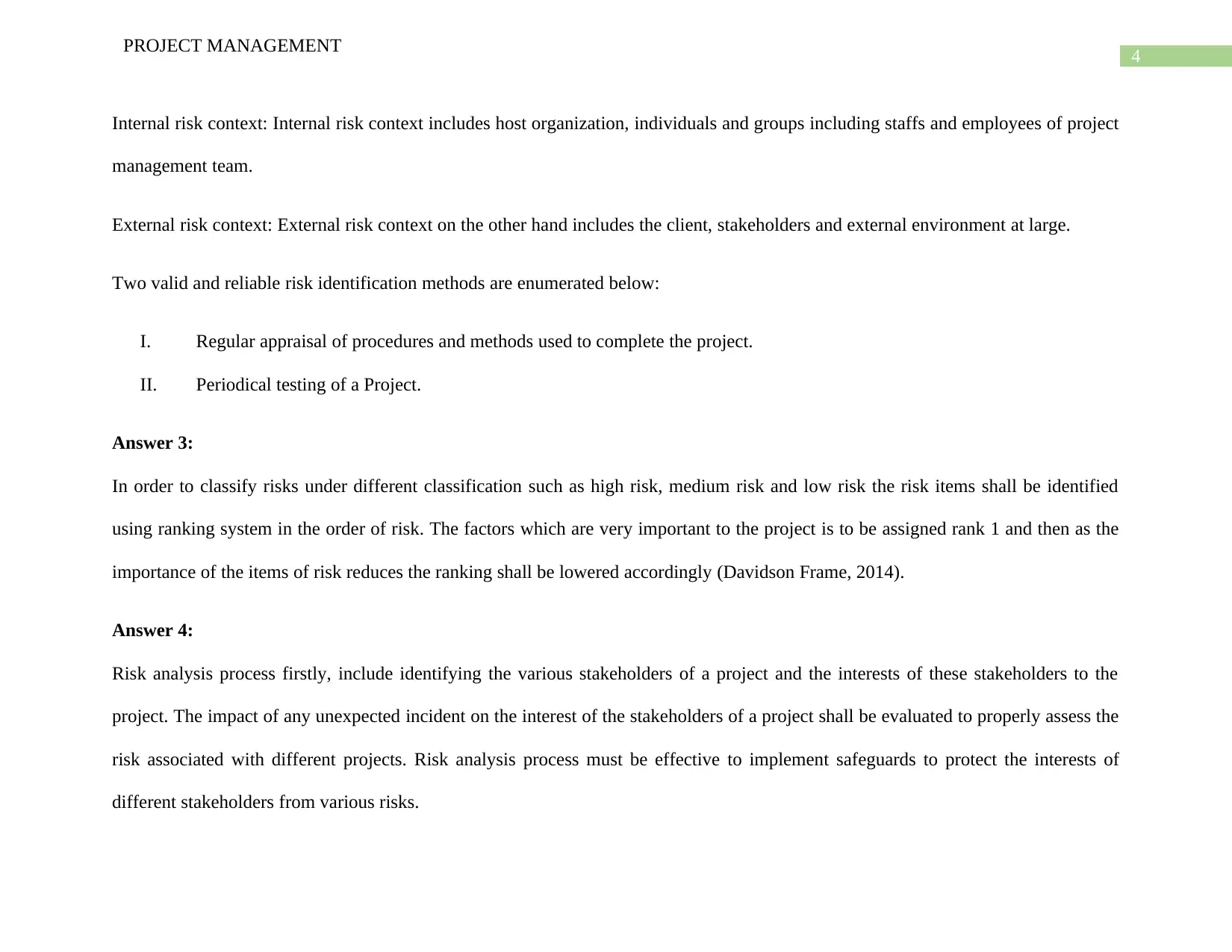
4
PROJECT MANAGEMENT
Internal risk context: Internal risk context includes host organization, individuals and groups including staffs and employees of project
management team.
External risk context: External risk context on the other hand includes the client, stakeholders and external environment at large.
Two valid and reliable risk identification methods are enumerated below:
I. Regular appraisal of procedures and methods used to complete the project.
II. Periodical testing of a Project.
Answer 3:
In order to classify risks under different classification such as high risk, medium risk and low risk the risk items shall be identified
using ranking system in the order of risk. The factors which are very important to the project is to be assigned rank 1 and then as the
importance of the items of risk reduces the ranking shall be lowered accordingly (Davidson Frame, 2014).
Answer 4:
Risk analysis process firstly, include identifying the various stakeholders of a project and the interests of these stakeholders to the
project. The impact of any unexpected incident on the interest of the stakeholders of a project shall be evaluated to properly assess the
risk associated with different projects. Risk analysis process must be effective to implement safeguards to protect the interests of
different stakeholders from various risks.
PROJECT MANAGEMENT
Internal risk context: Internal risk context includes host organization, individuals and groups including staffs and employees of project
management team.
External risk context: External risk context on the other hand includes the client, stakeholders and external environment at large.
Two valid and reliable risk identification methods are enumerated below:
I. Regular appraisal of procedures and methods used to complete the project.
II. Periodical testing of a Project.
Answer 3:
In order to classify risks under different classification such as high risk, medium risk and low risk the risk items shall be identified
using ranking system in the order of risk. The factors which are very important to the project is to be assigned rank 1 and then as the
importance of the items of risk reduces the ranking shall be lowered accordingly (Davidson Frame, 2014).
Answer 4:
Risk analysis process firstly, include identifying the various stakeholders of a project and the interests of these stakeholders to the
project. The impact of any unexpected incident on the interest of the stakeholders of a project shall be evaluated to properly assess the
risk associated with different projects. Risk analysis process must be effective to implement safeguards to protect the interests of
different stakeholders from various risks.
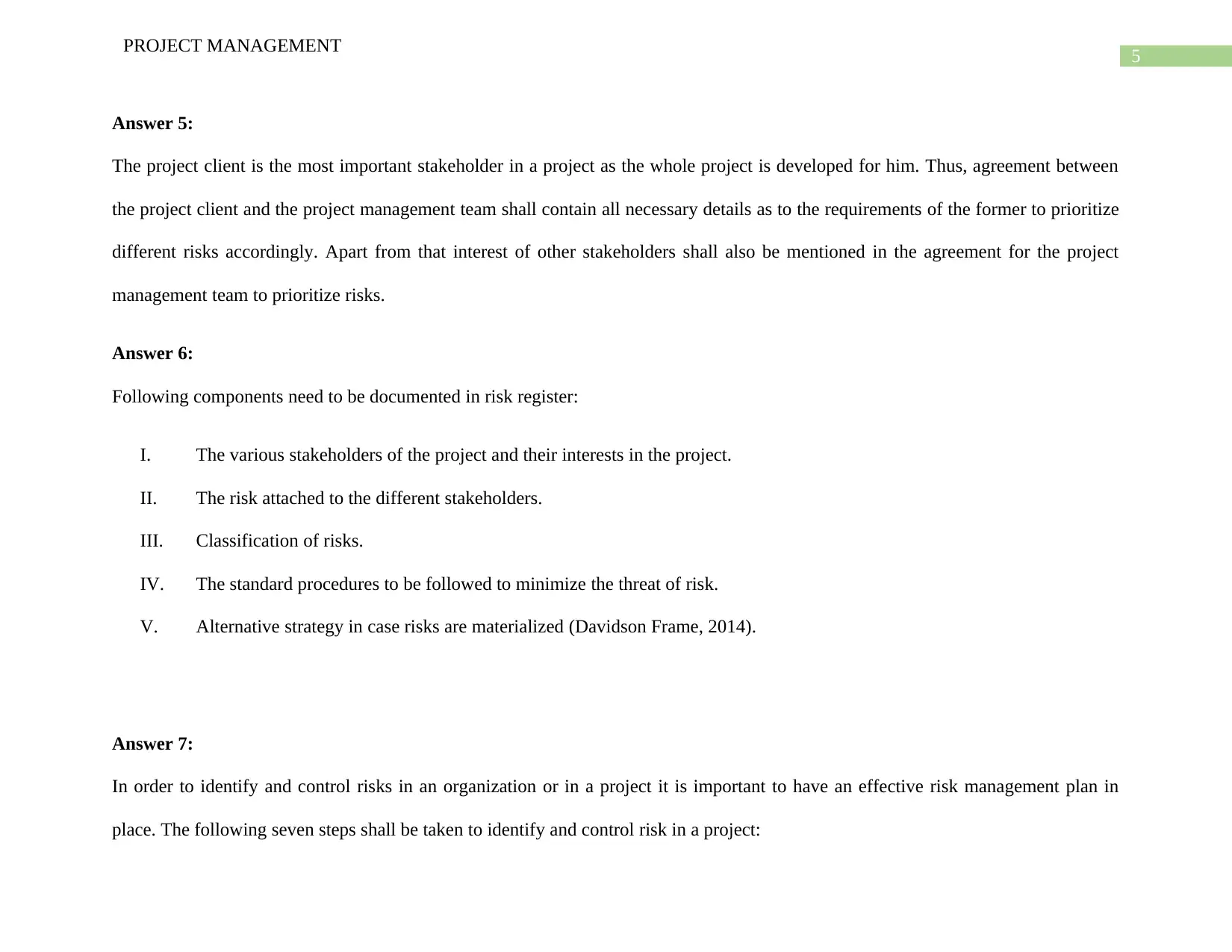
5
PROJECT MANAGEMENT
Answer 5:
The project client is the most important stakeholder in a project as the whole project is developed for him. Thus, agreement between
the project client and the project management team shall contain all necessary details as to the requirements of the former to prioritize
different risks accordingly. Apart from that interest of other stakeholders shall also be mentioned in the agreement for the project
management team to prioritize risks.
Answer 6:
Following components need to be documented in risk register:
I. The various stakeholders of the project and their interests in the project.
II. The risk attached to the different stakeholders.
III. Classification of risks.
IV. The standard procedures to be followed to minimize the threat of risk.
V. Alternative strategy in case risks are materialized (Davidson Frame, 2014).
Answer 7:
In order to identify and control risks in an organization or in a project it is important to have an effective risk management plan in
place. The following seven steps shall be taken to identify and control risk in a project:
PROJECT MANAGEMENT
Answer 5:
The project client is the most important stakeholder in a project as the whole project is developed for him. Thus, agreement between
the project client and the project management team shall contain all necessary details as to the requirements of the former to prioritize
different risks accordingly. Apart from that interest of other stakeholders shall also be mentioned in the agreement for the project
management team to prioritize risks.
Answer 6:
Following components need to be documented in risk register:
I. The various stakeholders of the project and their interests in the project.
II. The risk attached to the different stakeholders.
III. Classification of risks.
IV. The standard procedures to be followed to minimize the threat of risk.
V. Alternative strategy in case risks are materialized (Davidson Frame, 2014).
Answer 7:
In order to identify and control risks in an organization or in a project it is important to have an effective risk management plan in
place. The following seven steps shall be taken to identify and control risk in a project:
⊘ This is a preview!⊘
Do you want full access?
Subscribe today to unlock all pages.

Trusted by 1+ million students worldwide
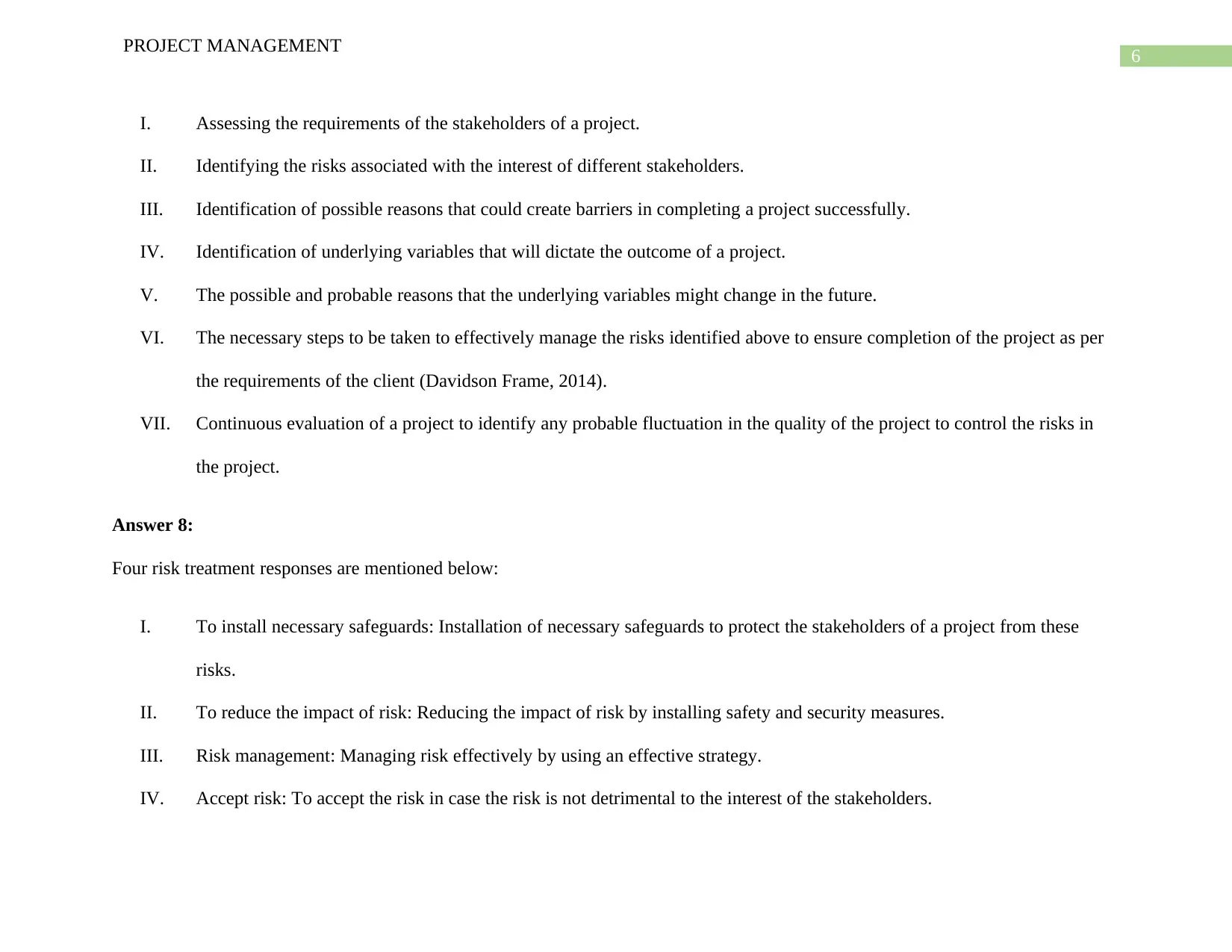
6
PROJECT MANAGEMENT
I. Assessing the requirements of the stakeholders of a project.
II. Identifying the risks associated with the interest of different stakeholders.
III. Identification of possible reasons that could create barriers in completing a project successfully.
IV. Identification of underlying variables that will dictate the outcome of a project.
V. The possible and probable reasons that the underlying variables might change in the future.
VI. The necessary steps to be taken to effectively manage the risks identified above to ensure completion of the project as per
the requirements of the client (Davidson Frame, 2014).
VII. Continuous evaluation of a project to identify any probable fluctuation in the quality of the project to control the risks in
the project.
Answer 8:
Four risk treatment responses are mentioned below:
I. To install necessary safeguards: Installation of necessary safeguards to protect the stakeholders of a project from these
risks.
II. To reduce the impact of risk: Reducing the impact of risk by installing safety and security measures.
III. Risk management: Managing risk effectively by using an effective strategy.
IV. Accept risk: To accept the risk in case the risk is not detrimental to the interest of the stakeholders.
PROJECT MANAGEMENT
I. Assessing the requirements of the stakeholders of a project.
II. Identifying the risks associated with the interest of different stakeholders.
III. Identification of possible reasons that could create barriers in completing a project successfully.
IV. Identification of underlying variables that will dictate the outcome of a project.
V. The possible and probable reasons that the underlying variables might change in the future.
VI. The necessary steps to be taken to effectively manage the risks identified above to ensure completion of the project as per
the requirements of the client (Davidson Frame, 2014).
VII. Continuous evaluation of a project to identify any probable fluctuation in the quality of the project to control the risks in
the project.
Answer 8:
Four risk treatment responses are mentioned below:
I. To install necessary safeguards: Installation of necessary safeguards to protect the stakeholders of a project from these
risks.
II. To reduce the impact of risk: Reducing the impact of risk by installing safety and security measures.
III. Risk management: Managing risk effectively by using an effective strategy.
IV. Accept risk: To accept the risk in case the risk is not detrimental to the interest of the stakeholders.
Paraphrase This Document
Need a fresh take? Get an instant paraphrase of this document with our AI Paraphraser
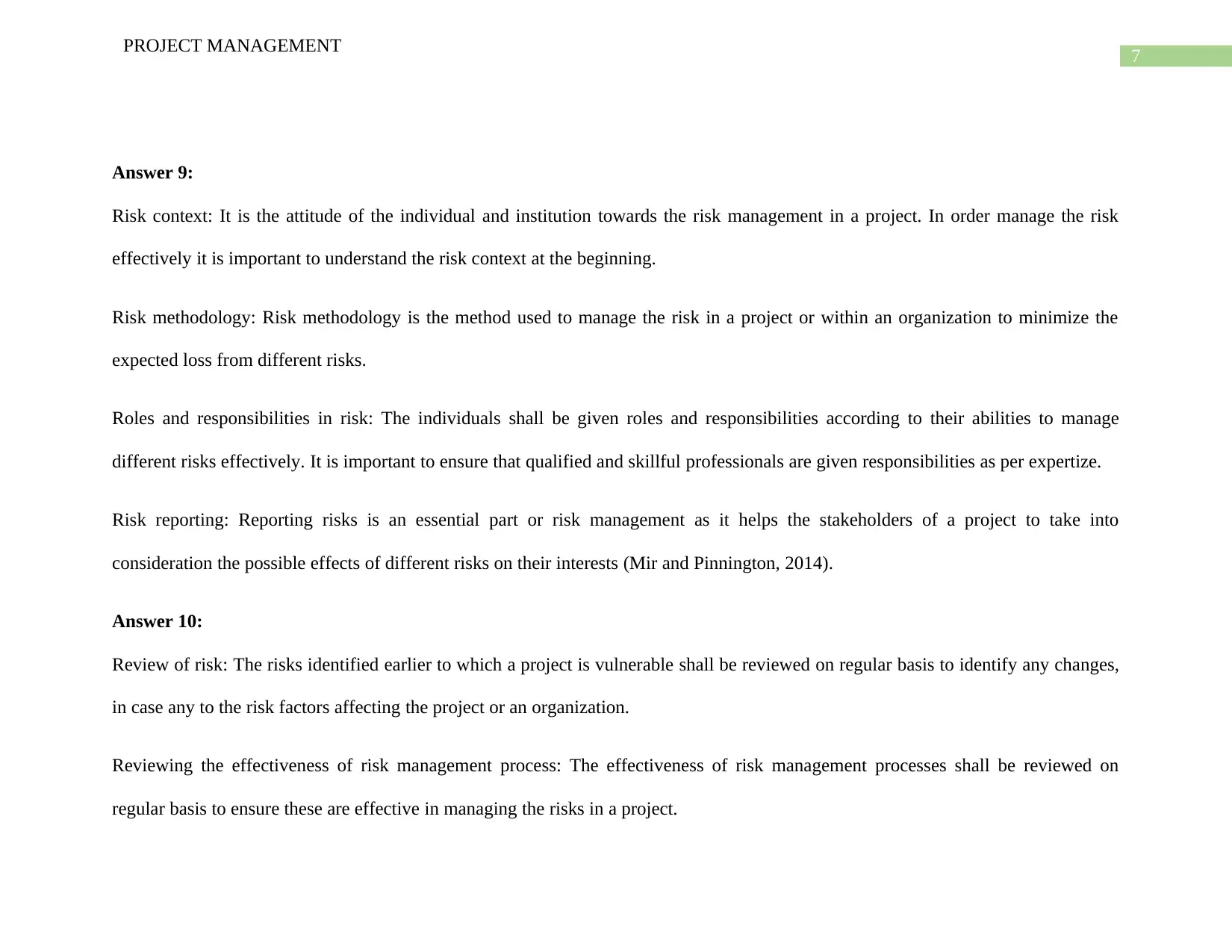
7
PROJECT MANAGEMENT
Answer 9:
Risk context: It is the attitude of the individual and institution towards the risk management in a project. In order manage the risk
effectively it is important to understand the risk context at the beginning.
Risk methodology: Risk methodology is the method used to manage the risk in a project or within an organization to minimize the
expected loss from different risks.
Roles and responsibilities in risk: The individuals shall be given roles and responsibilities according to their abilities to manage
different risks effectively. It is important to ensure that qualified and skillful professionals are given responsibilities as per expertize.
Risk reporting: Reporting risks is an essential part or risk management as it helps the stakeholders of a project to take into
consideration the possible effects of different risks on their interests (Mir and Pinnington, 2014).
Answer 10:
Review of risk: The risks identified earlier to which a project is vulnerable shall be reviewed on regular basis to identify any changes,
in case any to the risk factors affecting the project or an organization.
Reviewing the effectiveness of risk management process: The effectiveness of risk management processes shall be reviewed on
regular basis to ensure these are effective in managing the risks in a project.
PROJECT MANAGEMENT
Answer 9:
Risk context: It is the attitude of the individual and institution towards the risk management in a project. In order manage the risk
effectively it is important to understand the risk context at the beginning.
Risk methodology: Risk methodology is the method used to manage the risk in a project or within an organization to minimize the
expected loss from different risks.
Roles and responsibilities in risk: The individuals shall be given roles and responsibilities according to their abilities to manage
different risks effectively. It is important to ensure that qualified and skillful professionals are given responsibilities as per expertize.
Risk reporting: Reporting risks is an essential part or risk management as it helps the stakeholders of a project to take into
consideration the possible effects of different risks on their interests (Mir and Pinnington, 2014).
Answer 10:
Review of risk: The risks identified earlier to which a project is vulnerable shall be reviewed on regular basis to identify any changes,
in case any to the risk factors affecting the project or an organization.
Reviewing the effectiveness of risk management process: The effectiveness of risk management processes shall be reviewed on
regular basis to ensure these are effective in managing the risks in a project.
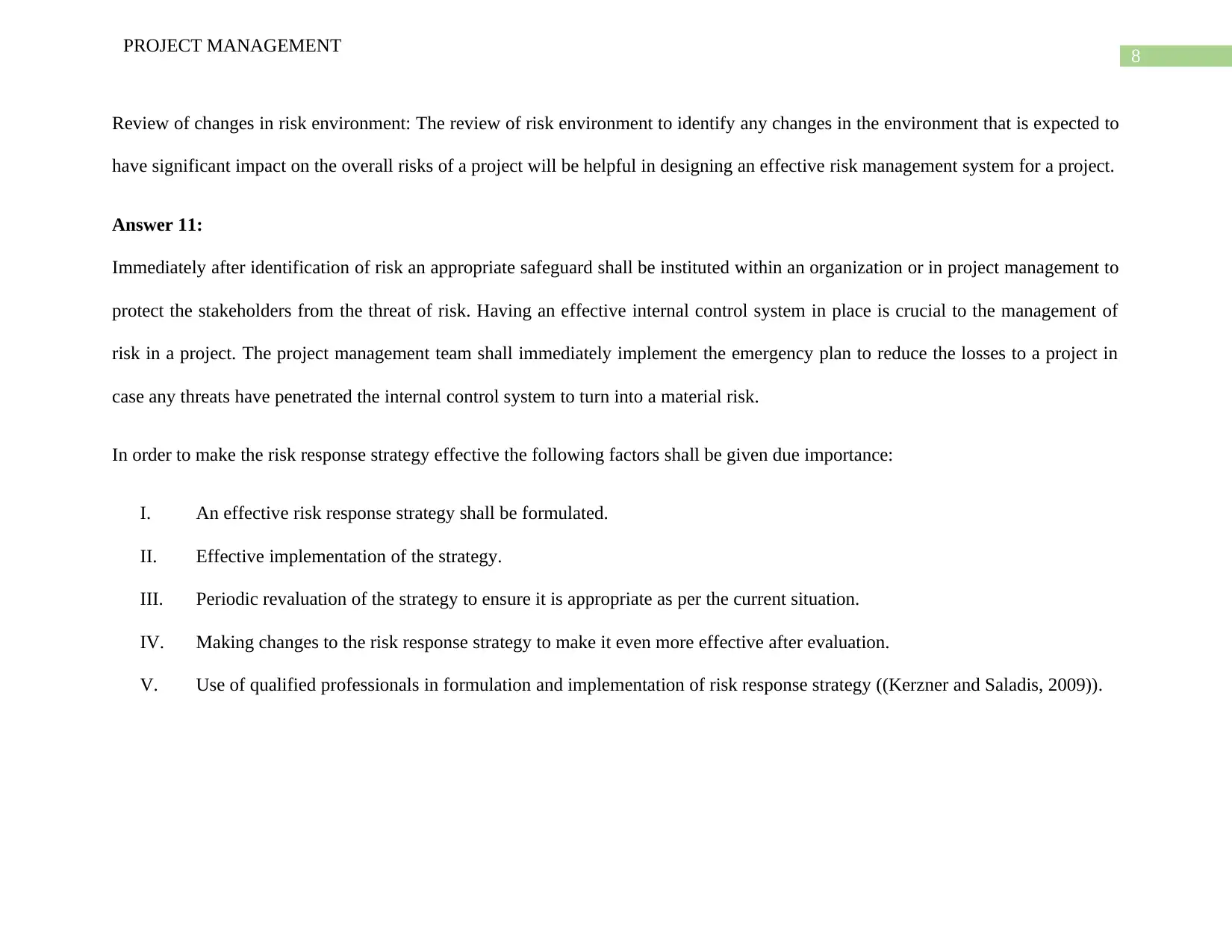
8
PROJECT MANAGEMENT
Review of changes in risk environment: The review of risk environment to identify any changes in the environment that is expected to
have significant impact on the overall risks of a project will be helpful in designing an effective risk management system for a project.
Answer 11:
Immediately after identification of risk an appropriate safeguard shall be instituted within an organization or in project management to
protect the stakeholders from the threat of risk. Having an effective internal control system in place is crucial to the management of
risk in a project. The project management team shall immediately implement the emergency plan to reduce the losses to a project in
case any threats have penetrated the internal control system to turn into a material risk.
In order to make the risk response strategy effective the following factors shall be given due importance:
I. An effective risk response strategy shall be formulated.
II. Effective implementation of the strategy.
III. Periodic revaluation of the strategy to ensure it is appropriate as per the current situation.
IV. Making changes to the risk response strategy to make it even more effective after evaluation.
V. Use of qualified professionals in formulation and implementation of risk response strategy ((Kerzner and Saladis, 2009)).
PROJECT MANAGEMENT
Review of changes in risk environment: The review of risk environment to identify any changes in the environment that is expected to
have significant impact on the overall risks of a project will be helpful in designing an effective risk management system for a project.
Answer 11:
Immediately after identification of risk an appropriate safeguard shall be instituted within an organization or in project management to
protect the stakeholders from the threat of risk. Having an effective internal control system in place is crucial to the management of
risk in a project. The project management team shall immediately implement the emergency plan to reduce the losses to a project in
case any threats have penetrated the internal control system to turn into a material risk.
In order to make the risk response strategy effective the following factors shall be given due importance:
I. An effective risk response strategy shall be formulated.
II. Effective implementation of the strategy.
III. Periodic revaluation of the strategy to ensure it is appropriate as per the current situation.
IV. Making changes to the risk response strategy to make it even more effective after evaluation.
V. Use of qualified professionals in formulation and implementation of risk response strategy ((Kerzner and Saladis, 2009)).
⊘ This is a preview!⊘
Do you want full access?
Subscribe today to unlock all pages.

Trusted by 1+ million students worldwide
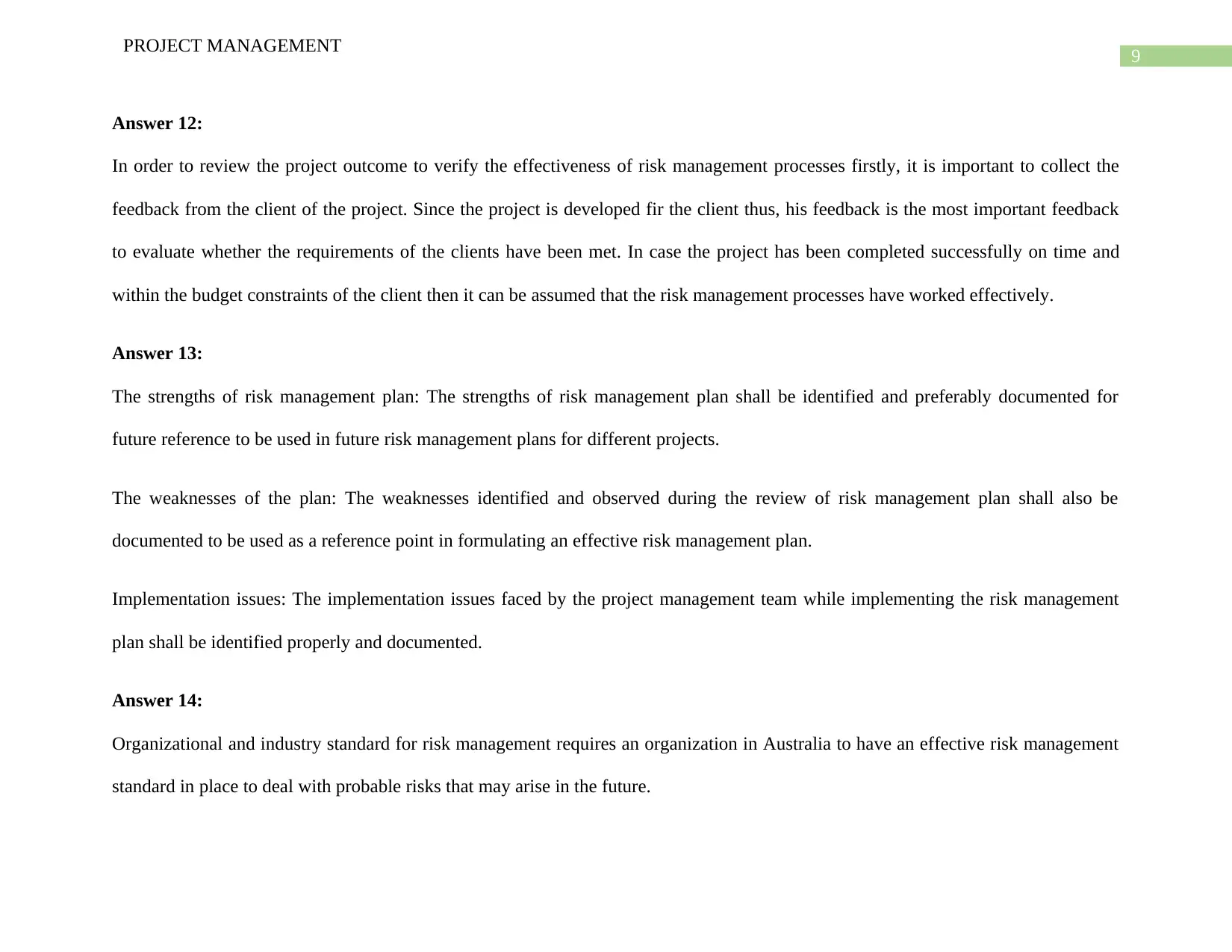
9
PROJECT MANAGEMENT
Answer 12:
In order to review the project outcome to verify the effectiveness of risk management processes firstly, it is important to collect the
feedback from the client of the project. Since the project is developed fir the client thus, his feedback is the most important feedback
to evaluate whether the requirements of the clients have been met. In case the project has been completed successfully on time and
within the budget constraints of the client then it can be assumed that the risk management processes have worked effectively.
Answer 13:
The strengths of risk management plan: The strengths of risk management plan shall be identified and preferably documented for
future reference to be used in future risk management plans for different projects.
The weaknesses of the plan: The weaknesses identified and observed during the review of risk management plan shall also be
documented to be used as a reference point in formulating an effective risk management plan.
Implementation issues: The implementation issues faced by the project management team while implementing the risk management
plan shall be identified properly and documented.
Answer 14:
Organizational and industry standard for risk management requires an organization in Australia to have an effective risk management
standard in place to deal with probable risks that may arise in the future.
PROJECT MANAGEMENT
Answer 12:
In order to review the project outcome to verify the effectiveness of risk management processes firstly, it is important to collect the
feedback from the client of the project. Since the project is developed fir the client thus, his feedback is the most important feedback
to evaluate whether the requirements of the clients have been met. In case the project has been completed successfully on time and
within the budget constraints of the client then it can be assumed that the risk management processes have worked effectively.
Answer 13:
The strengths of risk management plan: The strengths of risk management plan shall be identified and preferably documented for
future reference to be used in future risk management plans for different projects.
The weaknesses of the plan: The weaknesses identified and observed during the review of risk management plan shall also be
documented to be used as a reference point in formulating an effective risk management plan.
Implementation issues: The implementation issues faced by the project management team while implementing the risk management
plan shall be identified properly and documented.
Answer 14:
Organizational and industry standard for risk management requires an organization in Australia to have an effective risk management
standard in place to deal with probable risks that may arise in the future.
Paraphrase This Document
Need a fresh take? Get an instant paraphrase of this document with our AI Paraphraser
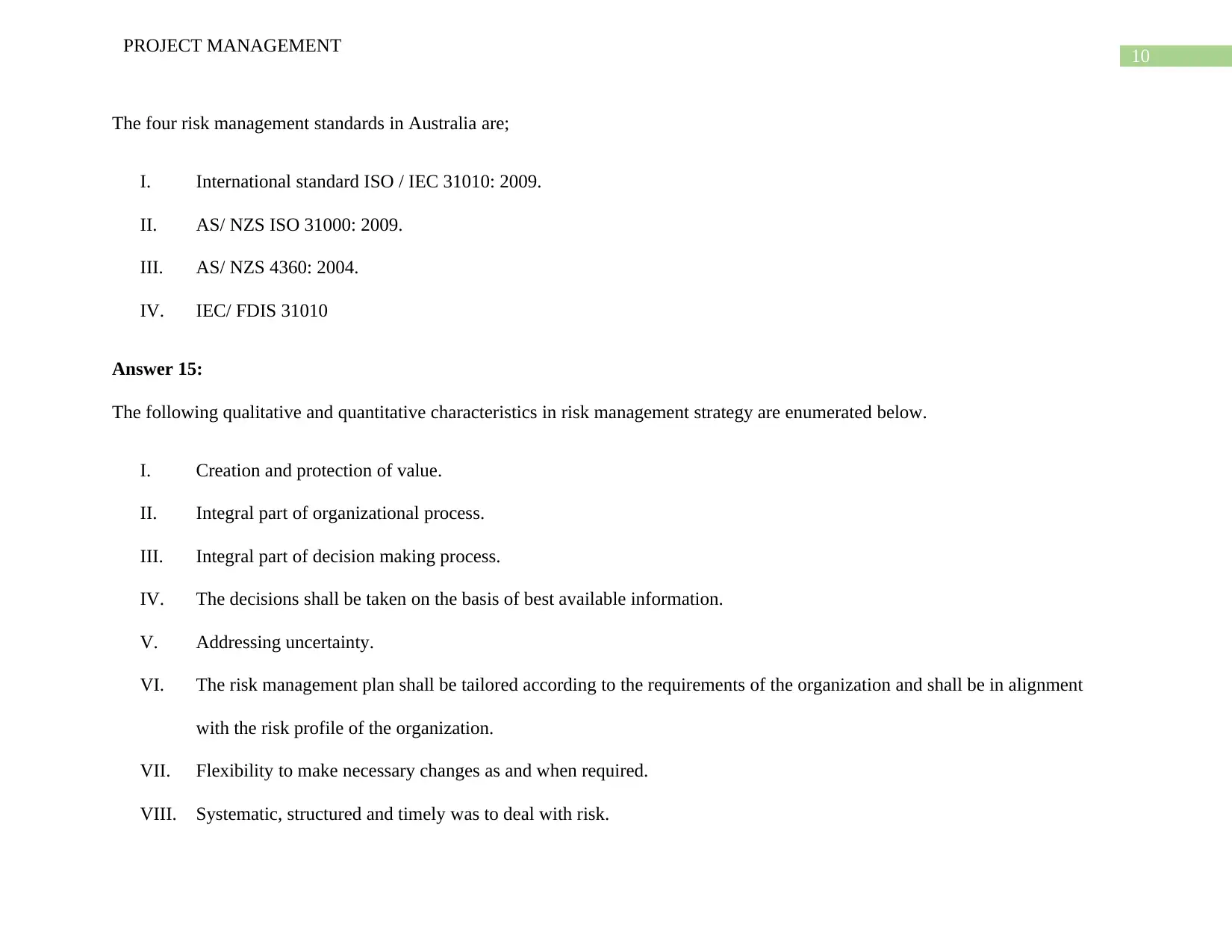
10
PROJECT MANAGEMENT
The four risk management standards in Australia are;
I. International standard ISO / IEC 31010: 2009.
II. AS/ NZS ISO 31000: 2009.
III. AS/ NZS 4360: 2004.
IV. IEC/ FDIS 31010
Answer 15:
The following qualitative and quantitative characteristics in risk management strategy are enumerated below.
I. Creation and protection of value.
II. Integral part of organizational process.
III. Integral part of decision making process.
IV. The decisions shall be taken on the basis of best available information.
V. Addressing uncertainty.
VI. The risk management plan shall be tailored according to the requirements of the organization and shall be in alignment
with the risk profile of the organization.
VII. Flexibility to make necessary changes as and when required.
VIII. Systematic, structured and timely was to deal with risk.
PROJECT MANAGEMENT
The four risk management standards in Australia are;
I. International standard ISO / IEC 31010: 2009.
II. AS/ NZS ISO 31000: 2009.
III. AS/ NZS 4360: 2004.
IV. IEC/ FDIS 31010
Answer 15:
The following qualitative and quantitative characteristics in risk management strategy are enumerated below.
I. Creation and protection of value.
II. Integral part of organizational process.
III. Integral part of decision making process.
IV. The decisions shall be taken on the basis of best available information.
V. Addressing uncertainty.
VI. The risk management plan shall be tailored according to the requirements of the organization and shall be in alignment
with the risk profile of the organization.
VII. Flexibility to make necessary changes as and when required.
VIII. Systematic, structured and timely was to deal with risk.
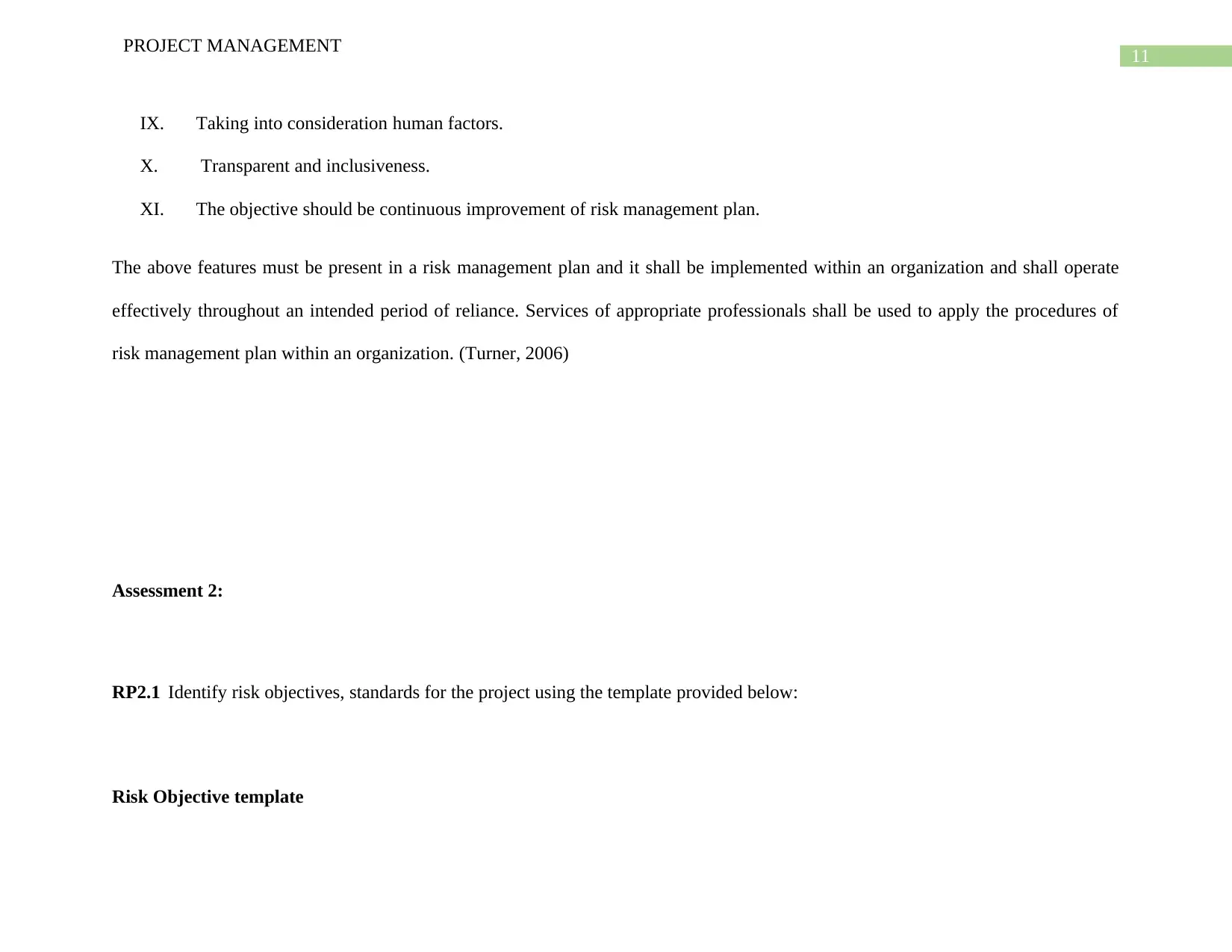
11
PROJECT MANAGEMENT
IX. Taking into consideration human factors.
X. Transparent and inclusiveness.
XI. The objective should be continuous improvement of risk management plan.
The above features must be present in a risk management plan and it shall be implemented within an organization and shall operate
effectively throughout an intended period of reliance. Services of appropriate professionals shall be used to apply the procedures of
risk management plan within an organization. (Turner, 2006)
Assessment 2:
RP2.1 Identify risk objectives, standards for the project using the template provided below:
Risk Objective template
PROJECT MANAGEMENT
IX. Taking into consideration human factors.
X. Transparent and inclusiveness.
XI. The objective should be continuous improvement of risk management plan.
The above features must be present in a risk management plan and it shall be implemented within an organization and shall operate
effectively throughout an intended period of reliance. Services of appropriate professionals shall be used to apply the procedures of
risk management plan within an organization. (Turner, 2006)
Assessment 2:
RP2.1 Identify risk objectives, standards for the project using the template provided below:
Risk Objective template
⊘ This is a preview!⊘
Do you want full access?
Subscribe today to unlock all pages.

Trusted by 1+ million students worldwide
1 out of 54
Related Documents
Your All-in-One AI-Powered Toolkit for Academic Success.
+13062052269
info@desklib.com
Available 24*7 on WhatsApp / Email
![[object Object]](/_next/static/media/star-bottom.7253800d.svg)
Unlock your academic potential
Copyright © 2020–2025 A2Z Services. All Rights Reserved. Developed and managed by ZUCOL.





